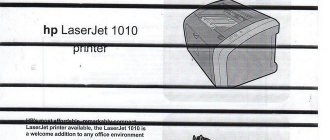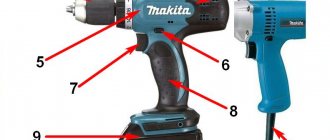How to check a laser level for accuracy
To be able to unconditionally rely on the readings of the laser level, it must be checked.
The technical characteristics of the model indicate the maximum permissible error for this device. It is indicated in mm/m (millimeters per meter). Naturally, the smaller it is, the better, and this is one of the key parameters that are worth paying attention to. But even when comparing different devices of the same model, you can see a significant difference in readings
For a normal repair result, the deviation should be minimal, and it can be determined by inspection. In theory, this check should be done before purchasing, but few stores will give you this opportunity. Then you can check the laser level at home, and if it does not pass the test, return it or exchange it (don’t lose the receipt). The verification procedure itself is in the video. There are quite a lot of manipulations, but they are not complicated.
Before you begin leveling the floor surface, you need to mark off the horizontal level of the room. In other words, draw ideal horizontal lines on the walls that can be used as a guide when leveling. Today we will look at how this can be done most easily, using traditional and modern devices.
Step-by-step lessons on plastering walls
Lesson 05. Plumb and building level
The laser building level is a technological device that replaced the water level. The device gives accurate results
, reliable and easy to use.
A laser level is a simplified version of a level. The action of the tool is based on the emission of light from an LED
, forming rays and points. The beam changes position due to mechanical, optical, electronic changes.
Based on the construction principle, there are two categories of laser levels:
- prism
or positional, the beam is based on a prism, a line is projected onto the surface; - rotary
, the beam is formed by a lens, capable of forming control points.
Prismatic laser levels are inexpensive and easy to use, the beam range is up to 20 meters. Rotary measuring tools are used by professional builders, have more capabilities, and the range has been increased to 500 m.
Before starting measurements , you must read the instructions and take care of safety precautions
. When working outdoors, take into account the temperature range of the tool and the degree of protection from moisture.
How to bring the device into working position?
Before work is carried out, the device is installed in the working position, fixed, and then adjusted.
The device has several modes:
- building horizontal lines;
- projection of vertical lines;
- cross construction mode. The vertical and horizon lines intersect to form an angle of 90 degrees;
- point projection mode.
Setting the level
The plastic, rubber-coated body of the device can be installed on any surface. Rigid fixation
the device is the main principle of fastening.
Important! During operation, vibrations of the device are not allowed; if it shifts, the results will be distorted. To install the laser level use:
To install the laser level use:
- smooth horizontal surfaces at hand: chairs, window sills, tables;
- Mounting with a tripod to the wall, rods and tripods.
Wall mounts hold the tool with suction cups or magnets, Velcro
. The tripod allows you to lift the device up, the rod is convenient for marking the ceiling. Accessories are included in the kit upon purchase or purchased separately as needed.
Settings
Preparing the device for operation consists of setting the level strictly horizontally
, it will depend on the type of laser level, and does not require professional skills.
Plug-and-play tools will be ready automatically. Adjustment occurs in the range of 5-10 degrees.
When adjusting the working position, the device emits a sound or light signal.
When turned on, the laser level will project the desired beam according to the set measurement mode.
A bright luminous line, one or more, a dot, a cross will appear on the surface.
note
When moving the device, the adjustment is always made again
!
The laser level is manually adjusted by aligning the bubble in the viewing window of the device to the central position
. The position is adjusted using screws located on the body.
Precautionary measures
Safety precautions for working with the device include protecting your eyesight.
. Direct exposure of the beam to unprotected eyes can cause various damages and diseases, including retinal detachment.
When working, be sure to use special glasses
, avoid beam exposure to those present, isolate pets. Safety glasses improve the visibility of lines in sunny weather.
Features of a laser level when configured correctly
Laser level device.
- The device shows very accurate measurement data. The error is no more than 1 mm.
- The point that the laser beam shows is clearly visible. This is much more convenient than the marks that are used in levels. You can work with this point or line immediately, without making additional markings. Construction equipment can start working immediately.
- The device takes measurements at tremendous speed, it does not require preliminary preparation, you just need to take it out of the case.
- Once placed in a horizontal position, the device does not require further maintenance. He will carry out all measurements independently and with great speed.
- No special training is required to operate the device. Anyone can work with it.
- One person is enough to take measurements. The device does not require a team of maintenance personnel.
Basically, a laser level is an improved descendant of previously used instruments, such as theodolite, tape measure, etc. With this device you can check any surface where special precision is required. To choose the most suitable device, you need to know their classification and names.
How to use the device
Let's look at the basic rules for using laser levels, which differ for different types of devices.
Point level
Before starting work, install the device on a flat horizontal platform. If it is possible to automatically adjust the position, the debugging mode is turned on and the horizontal adjustment is made. If this function is not available, a regular bubble level is used. Points are marked on the surface, which are either the centers of future holes, or define straight lines for subsequent work.
Crossliner
The device is installed and leveled horizontally. Lines are projected onto vertical or horizontal surfaces that determine the level of installation of various elements, the axis of laying tiles, etc. If necessary, two perpendicular lines are used, or one horizontal and two vertical, defining the dimensions of the opening or other element.
Rotary
Rotary models are used when installing planes - suspended ceilings, floor screeds, when gluing wallpaper and other work that requires the formation of a flat horizontal plane. The device is installed on a flat surface with the required height; if necessary, it can be suspended from the ceiling. The height of the rotation plane is set, aligned with the light line of the device, after which marking of walls or direct work is carried out.
How to use a laser level
The devices are easy to use and are available in a variety from specialized to universal. Structurally, they can be very different, but they all include two components: the laser itself and a platform, which, when used, can be placed on a plane, mounted on a wall, or attached to a tripod. The platform is equipped with leveling devices. These can be bubble levels, a pendulum and magnets with electronic sensors, adjusting screws. The accuracy of the marking depends on the calibration and leveling accuracy.
We advise you to study - Bedroom in Provence style: design features, colors, decor, furniture, textiles
How to use simple devices
The simplest amateur devices are oriented in space using bubble levels. They are great for home use, are inexpensive, and consume little energy.
https://youtube.com/watch?v=DcCA6UuBBXo
How to use self-leveling
Self-leveling instruments are more accurate. They are designed for self-orientation in space from a position “close to the horizon”, that is, they require preliminary manual adjustment to bubble levels before the self-leveling device takes over further fine-tuning. The precise orientation of the device is carried out using a pendulum mechanism, which, under its own weight, will take on a perfectly horizontal position.
Fully automatic devices
An even more complex solution for finding verticals and horizontals is to equip laser levels with adjustment servo drives controlled by smart electronics. Such devices provide significant flexibility in use (for example, you can turn off vertical alignment and tilt the level) and a large range of self-regulation. For those types of work in which it is necessary to frequently move the device, self-leveling mechanisms are justified by saving time and guaranteed measurement accuracy.
Criteria for choosing laser levels
The classification of laser levels has already been discussed above. Let us add that today the market offers mainly two varieties that are most in demand. These are self-leveling and rotary devices.
The first are the tools with which laser planes are built. Within this category there are two groups:
- Operating on the basis of a pendulum magnetic damper compensator. The latter simply set the level without human intervention in the horizontal plane due to the influence of magnets on the pendulum.
- The design of which includes an electronic compensator. This is a more modern model with more accurate level setting, and therefore the ability to reduce errors.
Self-leveling model of a laser level Source www.artem-tools.ru
How to work with a level
Laser levels can have different sets of functions. In the basic version, it is possible to obtain vertical and horizontal planes, as well as include them together and obtain an intersection. In some models it is possible to obtain a point at the zenith and below the device (plumb, point - nadir), there is also a function of constructing two parallel vertical planes. Additional features are useful, but their presence increases the cost as the system becomes more complex. Some manufacturers add tripods or platforms to the basic package that can be mounted on the wall with a screw or magnet.
The main functions of a household-grade level (plane builder)
The models also differ in the possible angle of the plane aligned in the horizontal surface (sweep angle). It can be from 110° to 360°. The easiest way to work is with the one that gives a complete plane, but it is a professional model and costs a lot. You can get a complete plane even with a small plane of luminescence. To do this, the device is rotated around its axis.
When using the device outdoors, the laser catcher may be useful. It is usually purchased separately. When purchasing, you need to check whether this model is compatible with your laser. Special glasses may be helpful. Firstly, they protect the eyes from accidental exposure to the laser, and secondly, they allow you to see the beam more clearly.
Use when working on the floor
It is convenient to use a laser level when leveling the floor. Place it approximately in the middle of the room and turn on the construction of a horizontal plane. A straight line is marked on the walls, along which it is convenient to make markings.
The laser beam is also displayed on any object that you place in its path. Using this property and a ruler (tape measure), you can find the most protruding and most “recessed” part of the floor. Using this data, you will determine at what minimum level you can screed the floor. Next, based on the found height, make marks on the walls and begin installing the beacons. They can also be placed along the beam. Having set the laser beam to the desired height, set the back of the lighthouse so that it is evenly illuminated by it.
Using the same horizontal surface, you can check how evenly the concrete is laid in the screed. The beam will be visible on the hillocks, and the depressions can be found using a rod.
How to use a laser level to lay floor tiles
You can also use a laser level when laying tiles on the floor. To do this, you need to get the intersection of the rays on the floor. Set the required mode, choose the direction in which you will lay the tiles and, along the line visible on the floor, align the seam.
What can it do on the walls?
Now let's look at how to use a laser level on walls even more actively:
- Check how crooked the wall is. Parallel to it, at a distance of several centimeters, beat off a horizontal plane with a laser. Using a ruler or tape measure, measure the distance from the beam to several points on the wall. This determines how much the wall is littered and in what place you can find recesses and bumps. This procedure is necessary when.
- Using the same technique, you can check the verticality of the corners.
- Mark a horizontal line for fastening something: furniture, profile, etc.
- Get a crosshair for laying tiles on the wall.
- Have a vertical line in order to horizontally, in order to evenly stick the border, etc.
- Check the verticality of the doors.
- Mark the line for laying.
You often have to use a laser level during repairs, and later in everyday life, for small jobs you often need it: to hang something straight, to set up household appliances (a washing machine, for example), etc.
DIY laser level repair
The level may be subject to shaking and falling. This affects the accuracy of the work. A large error appears or the laser beam disappears completely. You can disassemble the device yourself and inspect it for visible defects. If there are none, make adjustments.
- Remove the batteries or battery. Unscrew the mounting bolts. Carefully separate the housing parts.
The level wiring is very thin
Shift all planes to the left
Horizontal line shifted
Hexagons and holes for adjustment
Arc instead of line
Adjustment screws for arc formation
Video: Restoring lost laser level settings
By following the rules for preparing for work, checking and adjusting the device, you will be able to make accurate markings. More detailed recommendations for your level model are in the instructions. By following them, you will avoid mistakes, further rework and get a good result. Studying the instructions for the first time may take a long time. But then you will learn the algorithm. Your actions will become automatic, which will allow you to make markings very quickly.
We bought a laser level on a tripod, but it does not indicate the correct level. How do we configure this level?
Recommendation one: if you are not a specialist, then it is better not to do this at all and contact a company that does this, but it is better to return such a laser level and get a new one. But if you have nowhere to turn, then you need to perform the following steps.
Read also: Which soldering iron to solder radio components
General laser level settings involve adjusting the vertical direction of the laser beam, which is carried out using a plumb line. If an arched line is detected, you need to open the beam formers, then use the screws to obtain a straight beam of light. After obtaining an ideal laser line, marks are made on the plumb line of all parts relative to the adjustment made.
This is corrected first and only then they move on to horizontal settings.
The horizontality needs to be adjusted only by very small movements of the block contained in the laser. First, you need to slightly unscrew the fixing screws and move the block with a thin plate, using it as a lever. Once the result is achieved, all rotating parts must be placed on glue. There is no need to use the fixing screws at all. Otherwise the whole setup will go wrong.
The use of a laser level when renovating an apartment greatly speeds up the entire work process and we can say that all professional renovation teams have it. At the same time, the presence of an expensive level of a master does not at all indicate the level of his qualifications - the simple crooked Fedya, having shown the customer a tool for 20K, will still fill the screed or make a suspended ceiling only due to his abilities. The majority of teams, without much concern, use inexpensive laser levels, while fully relying on the accuracy of Chinese junk. And almost all craftsmen, after purchasing a laser level, never check it for accuracy, and all errors in setting the level begin to come to light during the work process, when all the jambs of the work done come out. Crooked partitions, blocked openings, screeds poured into a slope, crookedly pasted wallpaper will immediately show the narrow-mindedness of such crooked hands. And there is no particular difference between an expensive and a cheap level in terms of trust in accuracy - the entire final adjustment of any laser level is mechanical and very clearly depends on the assembler in production.
Using the most high-precision tools with zero deviations at any distance (water level and plumb line), you can check your laser level without any problems and, if possible, adjust it almost perfectly (0.00 mm at 15 meters). When renovating an apartment, a greater distance is usually not required, and the laser emission line itself begins to blur at long distances.
If there is no water level, you can check the laser level by ordinary counter measurements at a preferably large distance (6-10 meters), which will provide a more accurate detection of the error.
With a plumb line, everything is simpler: having attached it to the ceiling, you will immediately see how the vertical of the level shines - along the plumb line or with an offset.
And now that all the initial information in three main areas is known, you can begin to configure the Chinese laser level and make it a real tool with almost zero tolerances.
Remove the device from the tripod and unscrew the 3 screws in the stand.
Remove the locking ring on the rotary axis of the tool and unscrew the 4 screws at the base.
There is a magnet fixed inside the stand, which is simply useless there - because... The pendulum itself is made of aluminum alloy, and the screw screwed on from below is made of brass. Quickly calming the pendulum with such materials simply does not work, which of course is a plus in this case. A super strong neodymium magnet would in any case prevent the pendulum from aligning properly and would also be part of the cause of the error. Instead of removing the magnet, it is advisable to simply increase the weight of the pendulum, which will make its alignment more stable, but will of course result in a longer settling time.
Next, unscrew 4 more screws on the body itself.
We remove the front part and see the pendulum itself and laser blocks with glass tubes that form a line from the laser point.
Read also: Homemade weather vane at home
In general, two through screws in the pendulum are the entire center for setting up the laser level. One adjusts the accuracy of the beam into the distance, the other vertical or horizontal - it’s up to you to decide what you need. Simply adjusting the vertical and horizontal at the same time will not work - when examining several such specimens, it was discovered that the inserted blocks, which are fixed with two screws, do not allow the lines of the cross to be scanned at an angle of exactly 90 degrees.
The setup itself is done in this form, with the front part removed. The half-disassembled instrument is installed back on the tripod, with parts of the base better secured so that the level does not accidentally fall while dragging for adjustment.
The entire setup begins with adjusting the vertical beam of the laser beam using a screw in the pendulum. In this case, if the line has an arc, then you will have to pick out the glue that fixes the beam formers and adjust the screws to achieve a straight line of glow along the entire length of the plumb line. Immediately after setting the ideal display of the laser beam on the plumb line, it is necessary to fix with glue all the details related to the adjustment.
The next step is to check the horizon using counter measurements or using hydraulic level marks, and if you additionally pull the cord from the edges of the line, you can also determine the arc shape of the glow, which is corrected first. Of course, if the horizon turned out perfect after previous manipulations, then you can simply rejoice. If not, then you can start adjusting it, during which the screws in the pendulum can no longer be touched because this will disrupt the newly configured vertical.
And therefore, adjusting the horizon is possible only by small movements of the entire block in which the laser is located. Before this, it is necessary to slightly loosen the fixing screws and carry out the shift itself with an awl, acting as a lever. After obtaining the desired result, it is also necessary to fix all the parts that were spinning with glue, but it is not advisable to touch the fixing screws, because when they are tightened and, accordingly, a sliding load is placed on the block itself, which they fix, all the adjustments made may disappear. Of course, it’s worth trying to tighten the fixing screws, and if you succeeded without knocking it down, then after congratulating yourself once again, you can proceed to the last stage - adjusting the horizon into the distance.
This adjustment can be made simply by taking counter measurements at two simultaneously visible corners of the walls at a distance of 5-6 meters from each other or using hydraulic level marks. If there are no such corners in the room, then you can use almost any thing to set it up: stepladders, or something leaning against the wall. All adjustments are made by a screw in the pendulum, which, when unscrewed or tightened, changes the center of mass of the pendulum and, accordingly, the angle of inclination of the laser luminescence line into the distance. Of course, you can use a hydraulic level to create marks, but you will still need to find it, fill it with water, check the correctness of the marks, and you will need an assistant. This sequence takes a lot of time, unlike simple counter measurements, in which the error is immediately shown. Once all tightening is completed, the screw on the pendulum must also be fixed with glue, which will maintain the setting during a wide variety of impacts during operation or transportation.
After this adjustment, the error of the laser level at the distance you specify will be practically zero. The accuracy of the water level and the plumb line will make the PG almost a standard of accuracy and you can easily wipe out critics or bullies with expensive laser levels











